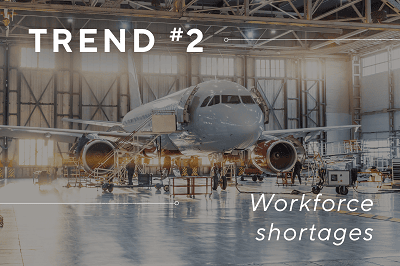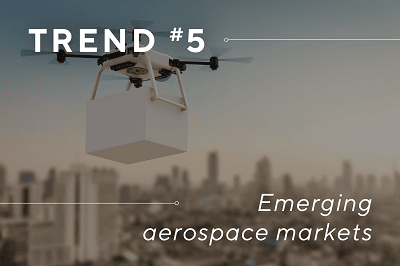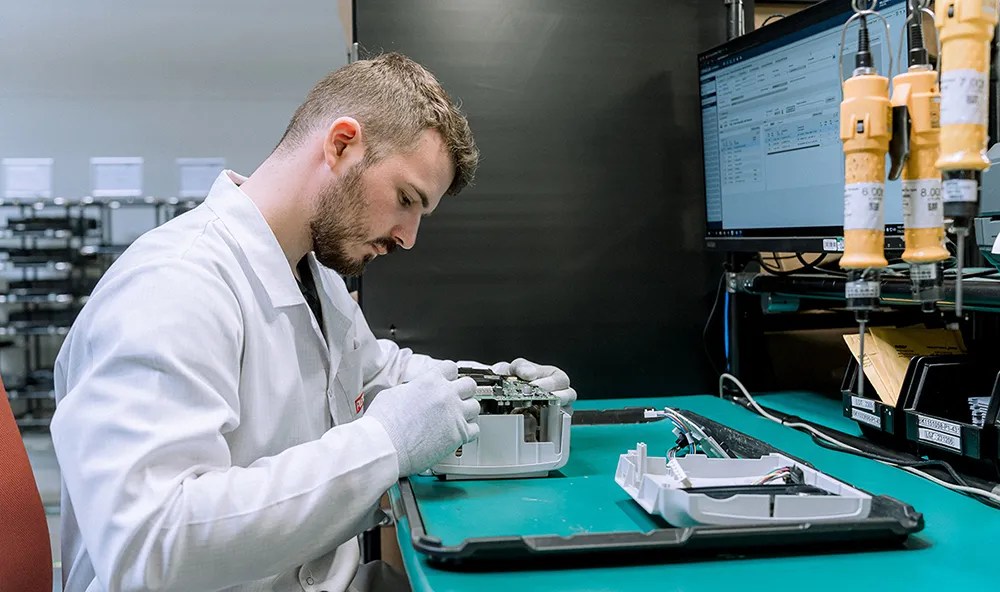Key Aerospace Industry Trends Shaping 2024

- Aerospace Industry Trend #1: Sustainable operations and net zero goals
- Aerospace Industry Trend #2: Workforce shortages
- Aerospace Industry Trend #3: Challenges in global supply chains
- Aerospace Industry Trend #4: Embracing digital transformation
- Aerospace Industry Trend #5: Emerging aerospace markets
- In the aerospace industry, growth hinges on partnerships.
The aerospace industry is finally showing signs of recovery after a few challenging years. According to the airline association IATA, 2023 was a year when air transportation nearly returned to its pre-pandemic pace of activity. Industry-wide passenger traffic grew by 40.1% in the first nine months of 2023 and reached 92.9% of pre-pandemic levels. This is a stunning performance and a testimony to the industry’s resilience, adaptability, and hard work.
So, are there only clear skies ahead for the aviation market? Not quite. The commercial aerospace industry is undergoing a remarkable transformation, driven by a convergence of macro trends that are revolutionizing our perspectives on air travel, technology, and sustainability. Here are some of the top aerospace trends that will require not only a shift in strategies, but also a closer collaboration with external partners to navigate.
Aerospace Industry Trend #1: Sustainable operations and net zero goals
 As the aerospace industry approaches the 2030 sustainability milestones, global efforts are underway to mitigate aviation emissions. A prominent solution is Sustainable Aviation Fuel (SAF). The United States plans an ambitious production target of 3 billion gallons of SAF by 2030, a substantial increase from the 15.8 million gallons used in 2022. Concurrently, Europe aims to raise SAF usage from 2% to 6% of total aviation fuel. A global consensus, involving over 100 countries, is committed to reducing aviation fuel carbon intensity by 5% by 2030, making SAF a focal point in 2024 discussions.
As the aerospace industry approaches the 2030 sustainability milestones, global efforts are underway to mitigate aviation emissions. A prominent solution is Sustainable Aviation Fuel (SAF). The United States plans an ambitious production target of 3 billion gallons of SAF by 2030, a substantial increase from the 15.8 million gallons used in 2022. Concurrently, Europe aims to raise SAF usage from 2% to 6% of total aviation fuel. A global consensus, involving over 100 countries, is committed to reducing aviation fuel carbon intensity by 5% by 2030, making SAF a focal point in 2024 discussions.
While SAF takes precedence, advanced technologies play a crucial role in fostering a sustainable aviation industry. Original Equipment Manufacturers (OEMs) are compelled to integrate sustainability throughout the value chain, driving the decarbonization of operations from design and manufacturing to supply chain and maintenance. Embracing Design for Sustainability (DfS/D4S) becomes instrumental in this journey.
The European Design Council underscores that over 80% of product-related environmental impacts are determined during the design phase. Strategies such as opting for low-carbon materials like green aluminum, incorporating recyclable components (Design for Recyclability), ensuring accessibility and repairability of assemblies (Design for Disassembly/Servicing), and implementing efficient waste management (Design for Dematerialization) emerge as proactive measures OEMs can adopt to initiate the decarbonization of their products.
These approaches highlight a significant stride toward a circular economy, potentially extending the service life of aerospace products. Whether through advanced data-driven and AI-based maintenance and servicing or the innovative reuse of components and materials via refurbishing and recycling, the industry is on the verge of a sustainable transformation.
Aerospace Industry Trend #2: Workforce shortages
 In the evolving post-COVID work landscape, the aerospace industry grapples with an unprecedented demand for talent at all levels of the supply chain. A resilient and highly skilled workforce is crucial for maintaining a competitive edge. While airlines have successfully onboarded numerous pilots amid the post-pandemic travel surge, the demand for professionals involved in aircraft construction, maintenance, and repair remains high. Amid increasing automation and widespread adoption of advanced digital technologies, the industry faces a persistent talent shortage, especially for individuals with advanced aerospace engineering skills and robust digital capabilities, including data scientists, AI/ML experts, and analytics specialists.
In the evolving post-COVID work landscape, the aerospace industry grapples with an unprecedented demand for talent at all levels of the supply chain. A resilient and highly skilled workforce is crucial for maintaining a competitive edge. While airlines have successfully onboarded numerous pilots amid the post-pandemic travel surge, the demand for professionals involved in aircraft construction, maintenance, and repair remains high. Amid increasing automation and widespread adoption of advanced digital technologies, the industry faces a persistent talent shortage, especially for individuals with advanced aerospace engineering skills and robust digital capabilities, including data scientists, AI/ML experts, and analytics specialists.
Forecasts from AAR Corp. indicate that the global aviation market will require 690,000 new mechanics over the next two decades to sustain the global fleet. This substantial demand, coupled with the ongoing need for thousands of aerospace engineers annually, necessitates innovative solutions. Outsourcing aerospace engineering services emerges as a viable strategy to address this talent shortage.
Collaborating with a product development partner in areas traditionally not invested in by aerospace companies provides access to a team of experts armed with enhanced digital skills and profound technical knowledge of the industry. This strategic collaboration not only facilitates the rapid expansion of the existing team but also establishes a long-term partnership, bringing invaluable know-how and resources across the entire value chain.
Aerospace Industry Trend #3: Challenges in global supply chains
 The aerospace supply chain is intensely concentrated with major players placing enormous demand on the wider industry. In addition, it is very complex with multiple tiers of suppliers that provide any part of the 1 million to 5 million components needed to build a modern aircraft. An average U.S. commercial aerospace company engages with over 12,000 tier-2 suppliers making global supply chains vulnerable to disruptions, bottlenecks, and limited visibility beyond tier-1 suppliers. Ongoing shortages of materials and components impact manufacturing plans, delivery timelines, and costs.
The aerospace supply chain is intensely concentrated with major players placing enormous demand on the wider industry. In addition, it is very complex with multiple tiers of suppliers that provide any part of the 1 million to 5 million components needed to build a modern aircraft. An average U.S. commercial aerospace company engages with over 12,000 tier-2 suppliers making global supply chains vulnerable to disruptions, bottlenecks, and limited visibility beyond tier-1 suppliers. Ongoing shortages of materials and components impact manufacturing plans, delivery timelines, and costs.
Recent macroeconomic events further strain supplier networks, with inflation driving up costs of raw materials and components. This disturbance affects demand forecasting, inventory planning, supply chain management, and cash flow, requiring a multifaceted approach to address the challenges. One developing trend involves companies restructuring their production approaches, placing greater emphasis on diversifying supply chains, utilizing dual-sourcing, nearshoring, and re-shoring, providing a secure environment for critical components.
While tactics may vary, the overarching goal remains consistent: reduce transportation time and fortify the supply chain. This aligns with a fundamental principle of supply chain management—building resilience by nurturing the supply base. Recognizing that most disruptions occur beyond tier-1 suppliers, the focus is on prioritizing the critical role of smaller suppliers in bolstering resilience.
Aerospace Industry Trend #4: Embracing digital transformation
 Aerospace companies are increasingly investing time and resources in digital initiatives, with AI-driven technologies serving as a crucial tool to address supply chain risks. The technology landscape, spanning cloud computing, the Internet of Things (IoT), AI/ML, digital twins, robotics, and additive manufacturing (AM), can be vast and overwhelming. However, these advanced, sometimes disruptive, technologies are essential for automating production lines, gaining profound insights into product design, enhancing predictive maintenance in aftermarket services, and implementing sophisticated testing systems for quality management.
Aerospace companies are increasingly investing time and resources in digital initiatives, with AI-driven technologies serving as a crucial tool to address supply chain risks. The technology landscape, spanning cloud computing, the Internet of Things (IoT), AI/ML, digital twins, robotics, and additive manufacturing (AM), can be vast and overwhelming. However, these advanced, sometimes disruptive, technologies are essential for automating production lines, gaining profound insights into product design, enhancing predictive maintenance in aftermarket services, and implementing sophisticated testing systems for quality management.
A strategic shift toward a smart factory approach can infuse much-needed resilience, speed, visibility, and flexibility into processes and workflows, effectively managing the dynamic business environment. Companies are gradually adopting new automation and testing technologies across different applications. Yet, the journey of digital transformation poses a considerable strain on a company's resources. While developing in-house automation or AI solutions has its advantages, it demands specific technical expertise, dedicated resources, and time commitment.
Aerospace Industry Trend #5: Emerging aerospace markets
 Developing a new product in the aerospace industry can be a difficult task. And when you add in the complex operating environment, various regulatory requirements, and extensive testing demands associated with product certification, the task may seem more daunting. Despite these hurdles, evolving consumer demands for enhanced technology, greater sustainability, reduced emissions, higher performance systems, and lower costs are driving the aerospace industry toward new product innovations and introductions in 2024.
Developing a new product in the aerospace industry can be a difficult task. And when you add in the complex operating environment, various regulatory requirements, and extensive testing demands associated with product certification, the task may seem more daunting. Despite these hurdles, evolving consumer demands for enhanced technology, greater sustainability, reduced emissions, higher performance systems, and lower costs are driving the aerospace industry toward new product innovations and introductions in 2024.
Beyond conventional aircraft, there has been a significant surge in funding, particularly in the realm of Advanced Air Mobility (AAM). Automated air transportation systems for passengers and cargo in both urban and rural settings are anticipated to revolutionize mobility. According to Deloitte, the AAM market is expectedto advance design, testing, and certification in 2024, paving the way for commercialization in 2025.
Moreover, substantial innovations and regulatory progress are steering the development of electric vertical takeoff and landing (eVTOL) aircrafts. TheVertical Flight Societyreports that 347 worldwide entities are actively working on more than 700 eVTOL aircraft concepts and designs. Amid fierce competition, companies can gain a competitive edge by being early adopters. Legacy aerospace players will have to closely collaborate with external partners, OEMs from other industries (e.g., automotive) and FAM startups to get access to technological innovations, gain supply chain management expertise and eventually drive mass production.
These trends signify a paradigm shift in aircraft design and operation, underscoring the industry's commitment to embracing electric propulsion as a pivotal enabler of greener and more sustainable aviation in the years ahead.
In the aerospace industry, growth hinges on partnerships.
As we advance into a future shaped by sustainability, technological innovation, and uncharted territories in air travel, the relationship between aerospace OEMs and strategic outsourcing emerges as a compelling narrative, paving the path for accelerated market entry and heightened competitiveness.
Whether it involves leveraging expertise during design and development, optimizing intricate supply chains, or streamlining manufacturing processes—outsourcing provides the agility, capabilities, and capacity to navigate this rapid evolution.
At Plexus, our design and manufacturingprocesses guarantee the highest level of quality, precision and traceability that are essential in the aerospace industry. If you’re unsure about the possibilities of such an outsourcing partnership, connect with our team today. We can guide you in determining the best course forward to bring your innovations to market—ensuring the safety of passengers, pilots, and flight crews who depend on your products.
- Aerospace Industry Trend #1: Sustainable operations and net zero goals
- Aerospace Industry Trend #2: Workforce shortages
- Aerospace Industry Trend #3: Challenges in global supply chains
- Aerospace Industry Trend #4: Embracing digital transformation
- Aerospace Industry Trend #5: Emerging aerospace markets
- In the aerospace industry, growth hinges on partnerships.


